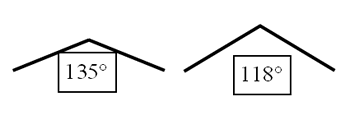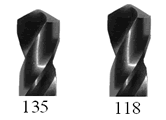|
Drill bits vary in their design and construction so that different materials can be drilled efficiently.
Most general purpose twist drills are designed to bore a variety of materials well,
but no single material most efficiently. The differences most effecting performance are the design of the cutting tip,
flute shape and material they are made from.
The biggest single factor effecting longevity of a drill bit is heat. When sufficient heat is generated at the cutting
edges of a drill bit, the edges deform and the bit becomes dull or "burned". A burned drill bit has had the temper of
the material negatively effected and renders the bit nearly useless without extensive re-grinding. If enough heat is
generated to melt the material being drilled, a build up can occur on the tip and prevent efficient drilling as well.
The amount of heat generated at the tip while drilling is effected by the material being drilled (hardness and melting
point), the speed of the drill (RPM) and the rate at which the drill bit is being fed into the material (feed rate).
The use of cutting fluids dissipates heat away from the cutting edges and is recommended on hard drilling operations
and some materials with low melting points.
Typical twist drill bits have either a 118º or 135º angle ground at the tip. The 118º tip provides for
more cutting surface and is best suited for softer materials (wood, plastic, aluminumˇ). This greater cutting surface
allows for more material to be cut with each revolution providing faster drilling. The 135º tip allows less
cutting edge surface, but permits more efficient drilling of harder materials (steel, stainless steel). Given the same
conditions (material, RPM and feed rate) the 118º point will produce more heat than the 135º.


The flutes of a twist drill exist to remove the drilled material (chips) as the bit cuts and progresses. If the material
is not removed, heat will build up faster and the bore will become clogged. Flutes vary in depth, angle and shape.
The more chips that can be cleared of the bore the more efficient the drill bit can operate.
Drill bits are produced from different kinds of material primarily varying in hardness. Most common is High Speed
Steel (HS). This material is of sufficient hardness for most drilling operations. To drill harder materials
(stainless steel) the drill bit needs to be harder for extended life and higher heat tolerance. Cobalt steel and
carbide steel are examples of materials harder than HS. Drill bits may also be coated to extended life, reduce heat
build up and discourage corrosion. Common examples are Black oxide coated, Titanium coated and Cobalt plated.
|
 Home
Home